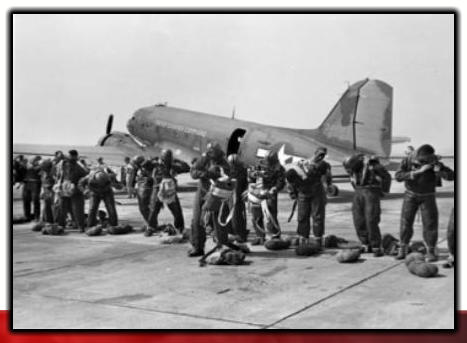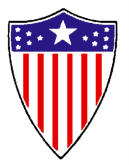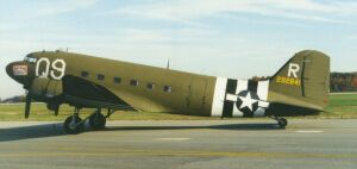


© Official Site Of 555th Parachute Infantry “Triple Nickle”. 2008










Headquarters 555th Parachute Infantry Battalion
Fort Bragg, North Carolina
1 February 1946
SECTION I - INITIAL ASPECTS
The 555th Parachute Infantry Battalion, with all Negro personnel, was activated at Camp Mackall, North Carolina on the 25th
of November 1944 under the supervision of Airborne Center, Cadre and initial personnel were obtained from the 555th
Parachute Infantry Company.
One of the first problems the organization encountered was severe lack of officer personnel to fill all key positions. This
situation was alleviated during the months of December and January.
The next problem, which never quite adjusted, was that of enlisted fillers. The organization undertook several measures to
solve the problem - (1) Submitted to higher headquarters a personnel requisition (2) When the aforementioned request failed
to produce the desired results, a request was submitted to higher headquarters that recruiting teams be selected and detailed
from this organization, to select and induce the necessary personnel to volunteer for parachute training and upon completion
of said training, be assigned to this organization. The last plan was rejected, when higher headquarters and the War
Department disseminated information to and through the ground forces, to the effect, that applications of Negro personnel for
parachute training would be accepted and said personnel would be accepted and said personnel would be detailed to
Parachute School, Fort Benning, Georgia, for parachutist qualification training.
In December the organization was instructed to detail to the Parachute School, by companies, a company cadre of one
officer and seventeen enlisted men, for a period of approximately four weeks per company, to process prospective fillers
through “A” stage (first week of the four week period of training) and to administratively care for these personnel through the
remainder of the training period.
This was accomplished, and the first company departed Camp Mackall, North Carolina for Fort Benning, Georgia, during the
month of December. Prospective fillers were not on a level with organizational requirements or expectations. Classes
approximated two hundred men, of which up to 60 per cent were rejected for various reasons, the major cause being that of
failing to meet physical requirements. The first company cadre returned the latter part of January with a relatively small group
of men. The second cadre departed the latter part of January. The situation in regards to the class or type of personnel
making application for and being detailed to the parachute school remained unimproved. Towards the first part of February
the situation showed such a high percentage of rejectees that the organization made a formal complaint to higher
headquarters on the types of applications accepted by the parachute school for processing. Higher headquarters requested a
list of rejectee personnel by name, rank, army serial number, former organization, and medical reasons for rejection.
The second cadre returned the latter part of February, at which time the third company cadre departed and remained at Fort
Benning, processing applications until June, at which time it reported to the parent unit at Pendleton Field, Oregon. During
the period February - June, the number of applications dropped appreciably, until in June the number of applications was
almost nil.
Upon several occasions the battalion reached T/O officer strength and has remained so, for the major portions of the
battalion’s existence.
SECTION II - TRAINING, INITIAL, AND GENERAL
Training for the battalion during the period November 1944 to May 1945 was not all that was desired or had been anticipated.
The battalion as such, never embarked on a formal, training program during this period. The lack of adequate, enlisted fillers,
for one reason, prevented the battalion from so doing. The battalion was promised by higher headquarters, that upon
reaching eighty percent (80%) of it’s T/O strength, it would be allowed to embark upon a formal training program. This was
never accomplished in view of the fact, that the battalion at no time was above approximate sixty-six percent of its T/O
strength. Training time was utilized in qualifying personnel with individual and crew served weapons, conducting cadre
schools, detailing various specialist to Army Service Force and Army Ground Force Schools, instructing in small unit
problems (as the personnel and situation) allowed, jumping demonstrations and small unit problems with other organizations
for higher headquarters; a situation which left much to be desired in the way of training of a combat team.
In March the battalion received orders from higher headquarters, to skeletonize all but one reinforced company, for training
purposes and a probable combat mission. This was done with the battalion executive officer as commanding officer of this
company. Various other officers were selected including the battalion S-3, as company executive officer, to cadre the
company.
The company was given an eight weeks training program, drawn up by the battalion S-3. The company seemingly
progressed very well along approximately four weeks of this training, when a halt was called and the battalion given a
security mission in the western portion of the United States.
SECTION III - FIRE SUPPRESSION ACTIVITIES
On 5 May 1945 this organization departed Camp Mackall, North Carolina for Pendleton, Oregon, this was a permanent
change of station. The battalion was assigned the mission of the recovery and destruction of Japanese balloon bombs, with
the added mission of the suppression of forest fires started by the aforementioned bombs. This mission was to be known to
all concerned agencies as, “The Fire-Fly Project,” and as far as the utilization of airborne army personnel was concerned,
was of an experimental nature.
The battalion arrived at Pendleton Field, Oregon, 12 May 1945, and was assigned o Headquarters Ninth Service Command,
Fort Douglas, Utah.
From 12 May 1945 until 22 May 45, the battalion was engaged in a minimum of military training, as the battalion freight
arrived at Pendleton Field some two weeks later, only such records and individual equipment, as carried by the troops was
available.
In anticipation of carrying out its mission assignment, the battalion placed renewed emphasis on physical conditioning,
leadership, first aid, and map reading.
The organization was located on an army air base, and there was a severe lack of training facilities for any type of ground-
troop training, i.e., firing ranges, training areas, parade grounds, etc. During this period other “Fire-Fly Project,” agencies
were contacted, via, United States Forestry Service, Ninth Service Command, the Fourth Air Force, in an effort to, ‘iron out
wrinkles,” and “gather loose ends” of the project from the “army airborne’ point of view; of these, there were many.
From 22 May to 6 June, personnel were introduced to the scope of the technique of forest fire suppression, and made use of
forestry service maps, which were different from the types of maps this organization had been trained to operate from. This
orientation and initial instruction was conducted under the direct supervision of the forestry service.
From 6 June to 15 June, a “bomb disposal school” was conducted by “bomb disposal personnel” from the Ninth Service
Command.
From 15 June to 23 June, all personnel were orientated in the use of the T-7 assembly (after jumping) by three (3) “live
jumps”: one of which was in heavy timber. Jumpmasters were instructed in the technique of dropping small groups of
approximately four men to a pass, in virgin timber, which was radically different from the jumping technique taught by the
army.
The aforementioned training continued through to July, insofar as training equipment allowed. Emphasis was put on training
six officers and ninety-four enlisted men to be placed on detached service at Chico AAF, Chico, California. This was
accomplished and the detachment departed Pendleton Field, Oregon via military aircraft, and arrived Chico AAF, 7 July. The
Chico Detachment (as the detachment was designated) was assigned the mission of covering “Region Five,” which
embraced the state of California, western portions of Nevada, Arizona, and southern portion of Oregon.
“Smoke Jump” training for the remainder of the battalion continued through 14 July, by which time, the major part of the
battalion was qualified as “Smoke Jumpers”. This training continued, concurrently with such other training as facilities
permitted, in the form of refresher training, with improvements on “Smoke Jumping technique,” as time and experience
brought forth. This training (revisions of technique) continued for the duration of the battalion’s assignment in the Northwest.
When the battalion had trained approximately 80% of its personnel, it was assigned the mission of covering Region One
(Montana). Region Four (Idaho) and Region Six (Oregon-Washington).
The first fire call for the Pendleton group came on July 20, in the Meadow Lake National Forest; fifty three enlisted men and
two officers answered the call. From 20 July to 28 August, the “Pendleton Group” answered nineteen fire calls in the Meadow
Lake, Bitter Root, Cabinet, Salmon, Deschutes, Chelan Wanatchee, Colvilla, Siskiyou, Whitman, Mt. Ricker, and Wallowa
National Forest, with one casualty resulting in death. This was due, not to a parachute malfunction, but to an error in the
“letdown” technique, on the part of the individual concerned.
The “Chico Detachment” answered its first fire call, on the 14 July, with fifty four enlisted men and two officers. This
detachment
covered seventeen fire calls, from 14 July to 10 October, in the Klamath, Trinity, Modoc, and Medecino National Forest.
Military training programs were instituted, in so far as training facilities allowed at both Pendleton and Chico.
These programs were interrupted from time to time or discontinued entirely due to the frequency of fire calls and high
casualty or injury rate.
As a technique of operations, “Fire Fighting SOPs” were established by both the Pendleton group and Chico Detachment. As
a record of operations a “Report of Forest Fires” form was initiated and required by fire guard detachment commanders.
Copies of both the aforementioned documents are attached.
In conclusion, the battalion makes the following recommendations, based upon its Forest Fire suppression activities - (1) That
where army airborne personnel is utilized in the suppression of forest fires, same be thoroughly indoctrinated for a period of
at least one month (four weeks), utilizing data based upon the experience of this organization. (2) That a smaller and slower
type aircraft (preferably the UC-64) be used, as the C-47 has proven both too large and too fast for this type of operation.
Headquarters 555th Parachute Infantry Battalion
Camp Mackall, North Carolina
30 November 1945
1. The following is an outline of the history of the 555th Para chute Infantry Company from its date of activation (30 December
1943) to its date of inactivation and/or redesignation (25 November 1944) prepared UP Par. 13 AR 345-105.
a. Original Unit
(1) 555th Parachute Infantry Company
(2) 30 December 1943
(3) Fort Benning, Georgia
(4) Par. 1, GO 40, hq. ABC, AGF, Camp Mackall, N.C., dtd. 23 December 1943
(5) Personnel obtained by recruiting (i.e. voluntary transfers) from other organizations.
b. Changes in Organization: Redesignated Company “A”, 555th Parachute Infantry Battalion per par 2, GO 13, Hq ABC,
AGF, Camp Mackall, N.C., dtd, 21 November 1944.
c. Strength Commissioned and Enlisted
(1) Commissioned; 1. Enlisted: 1 (Period 30-31 Decem ber 1943 inclusive).
(2)
(3) Strength for Month of:
Net Net
Increase Decrease
O. EM.
O. EM.
JANUARY 1944
6
19
0
0
FEBRUARY
4
0
0
0
MARCH
0
15
0
0
APRIL
0
70
0
0
MAY
0
57
3
0
JUNE
2
0
0
5
JULY
0
0
0
23
AUGUST
0
19
0
0
SEPTEMBER
0
0
1
5
OCTOBER
0
10
0
0
NOVEMBER (As of 25th)
0
7
0
0
(4) Commissioned Strength 7; Enlisted Strength 165
d. Stations (Permanent or Temporary) of unit or parts thereof.
(1) Arrived Camp Mackall, N. C., 17 July 1944 as per Ltr. Hq TPS, SUBJECT; Transfer of 555th Parachute Infantry Company,
dtd, 13 July 1944, file No. 325, 445.
(2) Departed Ft. Benning, Georgia, 15 July 1944, for Camp Mackall, N.C. as per Ltr. Hq. TPS, Subject: Transfer of 555th
Parachute Infantry Company, dtd, 13 July 1944, File 325,445
e. Marches
Monday, 14 August 1944, nine (9) mile March in two hours with full field equipment, 0800-1030; Physical conditioning-three
(3) miles asphalt topping; six miles clay top-weather clear.
Tuesday, 12 September 1944, twenty-five (25) mile March in eight (8) hours with full field equipment; 0400-1200 physical
conditioning-six miles asphalt topping, nineteen (19) miles clay top weather clear.
This organization made various other marches in connection with training i.e. marches to training areas of one (1) to nine (9)
miles distances; marches directly a part of tactical principle (route march and approach march); Marches Directly a part of
physical conditioning (runs of two (2) to five (5) miles dis tances, of which were not and are not recorded.
f. Campaigns
None
g. Battles
None
h. Commanding Officers in important engagements
In applicable
i. Loses in Action; officers and men.
None (In training: 1 EM,
j. Former and present members who have distinguished themselves in action:
None
k. Photographs of Personnel, important scenes or events
None
JAMES H. PORTER
Captain, Inf.
Commanding
1 Incl: 1 -Statistical Summary of Parachute Jumps
MEMORANDUM: Statistical Summary of Parachute Jumps
The following is an extract from the “Parachute Jump Report Log” of this organization for the 555th Parachute Infantry
Company.
Total for Jumps
Fatalities
Fractures
Other Injuries
(Aggregate June 44)
(to date 1036)
1
2
0
July 44
112
0
0
3
August
99
0
0
10
September
0
0
0
0
October
44
0
0
0
November
230
0
0
7
Grand Total to date
1477
1
2
20
(Nov.44)
JAMES H. PORTER
Captain, Infantry
Commanding




















